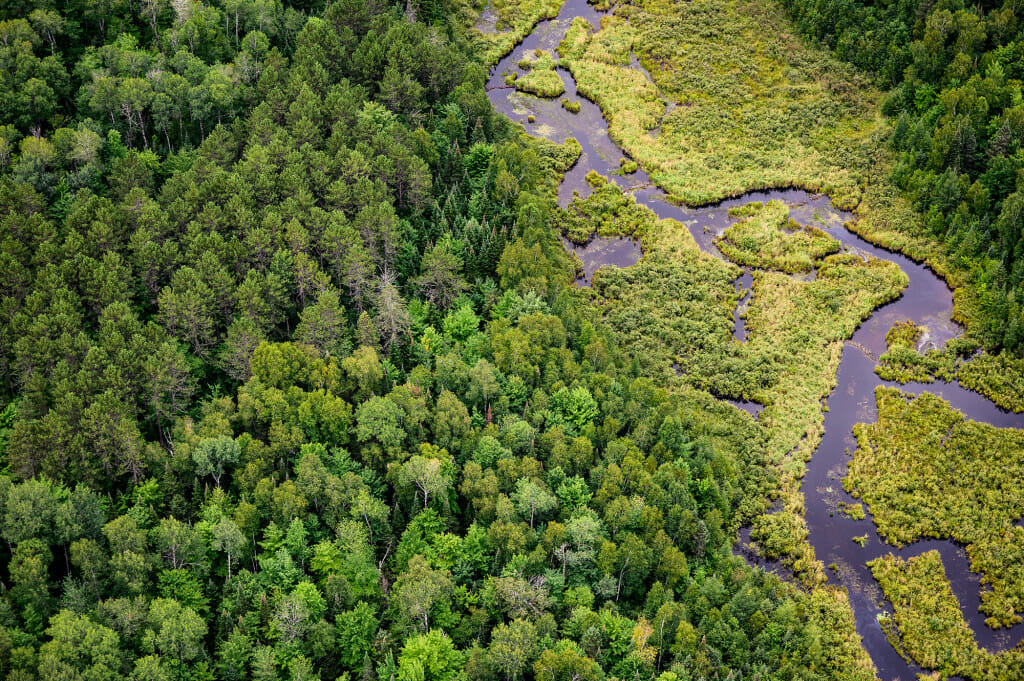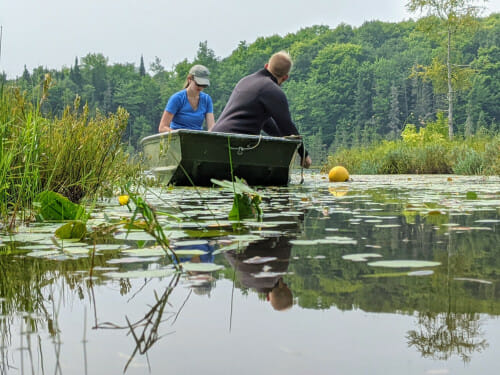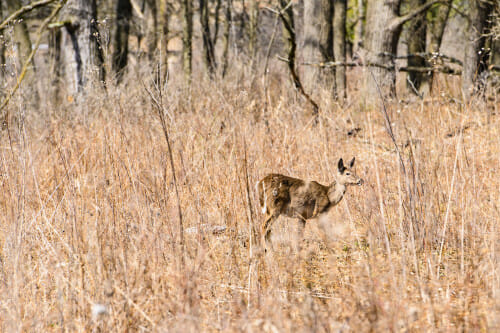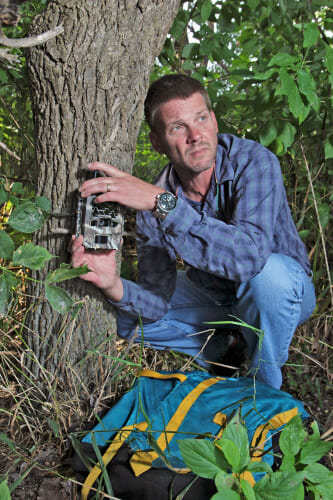Researching Wisconsin’s great outdoors

Woods and wetlands in the Chequamegon-Nicolet National Forest of northern Wisconsin. Photo: Jeff Miller
When it comes to helping Wisconsin residents and the state’s economy, you Can’t Stop a Badger. This March, see how UW–Madison scientists conduct cutting-edge research that delivers tangible benefits for Wisconsinites and the world. Follow along using #CantStopABadger on social media. Your support can help us continue this work.
Outdoor recreation is synonymous with the Wisconsin experience. From sunny summer days on the lake to crisp fall mornings hunting in the woods and brisk hikes to campsites along the shores of the Apostle Islands National Lakeshore, there’s a lot to love about the state’s natural ecosystems. Scientists at the University of Wisconsin–Madison are making sure the state’s lakes, forests and wildlife remain for future generations to enjoy.
Grace Wilkinson and Timothy Van Deelen are just two of the many researchers at UW–Madison putting their love for the outdoors to work to keep Wisconsin ecosystems healthy for years to come.
Resilient lakes
Wilkinson, a professor at the Center for Limnology in the College of Letters & Science, grew up surrounded by the joys of the Great Lakes region. She remembers noticing at an early age that sometimes while swimming in a lake, her toes would kick down into much colder water, a startling phenomenon she now knows is called stratification.

Grace Wilkinson
“I was always fascinated about what was going on below the waterline,” Wilkinson says. “That fascination sort of morphed into using my passion to try to push the dial forward on science to be better stewards of these ecosystems.”
By 2010, she was conducting whole lake experiments as a graduate student alongside other UW–Madison limnologists.
Nothing in an ecosystem happens in a vacuum, and Wilkinson says whole lake experiments offer the chance to zoom out and consider a much bigger picture.
“Lakes are connected to the landscape around them,” she says. “They are the integrators of everything that’s happening in the watershed.”
As the birthplace of North American limnology, UW–Madison has a rich history of expanding scientific understanding of lakes and other inland waters. In 1950, Professor Arthur Hasler realized that whole lake experiments presented a powerful tool and secured for study the isolated and undeveloped Peter and Paul lakes, offering scientists at UW–Madison and elsewhere unique opportunities to understand lakes as integrated systems.
Now, Wilkinson and her collaborators are using these same lakes to conduct experiments to help improve methods of predicting and preventing harmful algal blooms in lakes across the state.

Ellen Albright, a post doctoral fellow, and Danny Szydlowski, a doctoral student, conducting a survey of aquatic plants in one of the experimental lakes included in Grace Wilkinson’s research.
Harmful algal blooms happen when lakes experience increases in nutrients like nitrogen and phosphorus, which can come from a variety of sources such as stormwater runoff, nearby farms and even industry. Excess nutrients in lakes can provide organisms called phytoplankton more fuel to multiply exponentially.
This can set off a chain reaction in the lake, where an excess of phytoplankton eventually leads to a depletion of available oxygen in the water, allowing some invasive fish species to thrive over native species. This means popular recreational species may face population declines.
Some blooms also consist of certain kinds of phytoplankton called cyanobacteria, which may release toxins that can be harmful to people and other animals who may be swimming or otherwise enjoying the water.
A lake that experiences frequent harmful algal blooms is also smelly, scummy and much less appealing to visitors.
“The tricky thing about these blooms is you can’t see them before they’re happening,” Wilkinson says. Her lab is looking for statistical indicators that would serve as early warning signs a lake may soon experience a harmful algal bloom.
The data they’re collecting can be used to build a framework for lake managers to look out for blooms and implement intervention strategies across the state. They especially hope their work will help support the busy lake managers working to keep people safe and the ecosystem resilient.
“In Wisconsin, part of our identity as a state are these freshwater lakes and our love for them,” Wilkinson says. “We care about preserving these systems, not just because of the economic benefits or the things that we get from them, but because they are culturally very important.”
Keeping an eye on wildlife

A white-tailed doe sporting her winter coat surveys the landscape while looking for food in Curtis Prairie at the University of Wisconsin–Madison Arboretum. Photo: Bryce Richter
Every fall, Tim Van Deelen purchases a deer hunting license and soaks in the outdoors. He’s one of the hundreds of thousands of Wisconsinites who participate in the tradition every year. At the end of the day, he — like every successful Wisconsin deer hunter — reports his harvest to the Wisconsin Department of Natural Resources.
“Getting data from hunters on hunted species has been a long-established tradition in Wisconsin going back to the 1950s,” he says.
That data remains especially relevant to Van Deelen, who is also a professor of forest and wildlife ecology at UW–Madison’s College of Agriculture and Life Sciences. He studies population dynamics of mammals in the Great Lakes region, especially deer.
White-tailed deer are an iconic species in Wisconsin and have been an important food source for generations. Still, deer can pose challenges to landowners and farmers, and where their numbers outpace their habitat, they can cause ecological damage as well. They can overgraze on understory plants in forests and affect the biodiversity of other species.
Hunting is one of the best ways, Van Deelen says, to help maintain deer populations at ecosystem-healthy levels. By collecting data on deer population dynamics around the state, his work helps wildlife managers refine their own management tools and inform hunting policy. Currently, he and his team are working with land managers to connect hunters to areas where deer populations are negatively affecting habitat health.

Tim Van Deelen sets up a camera trap which helps in monitoring the presence of several species in the wild for his research.
“You have to really understand how the population responds to hunting,” he says. “From kind of a general interest in population dynamics, I get drawn into those questions of applied research.”
Hunting could also provide opportunities to mitigate chronic wasting disease, a fatal neurological disease that spreads among deer and related species.
“We believe that reducing the deer population would help reduce the spread of the disease,” Van Deelen says. “Having high deer harvest rates in CWD areas would intercept some of the animals that might be infected, therefore you prevent a new spot from becoming infected.”
Van Deelen also studies native wildlife populations in the iconic Apostle Islands, where he gains insights into how animals and their interactions with one another affect competition for resources and beneficial communities that may exist between species on the islands.
In national park lands like the Apostle Islands National Lakeshore, visitors go with high hopes of seeing native wildlife. Van Deelen works with the National Park Service to give them an idea of what the wildlife communities’ dynamics are so they can strive to cultivate healthy natural biodiversity.
“People love to see wildlife, and they want to know that the wildlife are being managed sustainably,” he says.
Subscribe to Wisconsin Ideas
Want more stories of the Wisconsin Idea in action? Sign-up for our monthly e-newsletter highlighting how Badgers are taking their education and research beyond the boundaries of the classroom to improve lives.
Tags: The Wisconsin Idea




